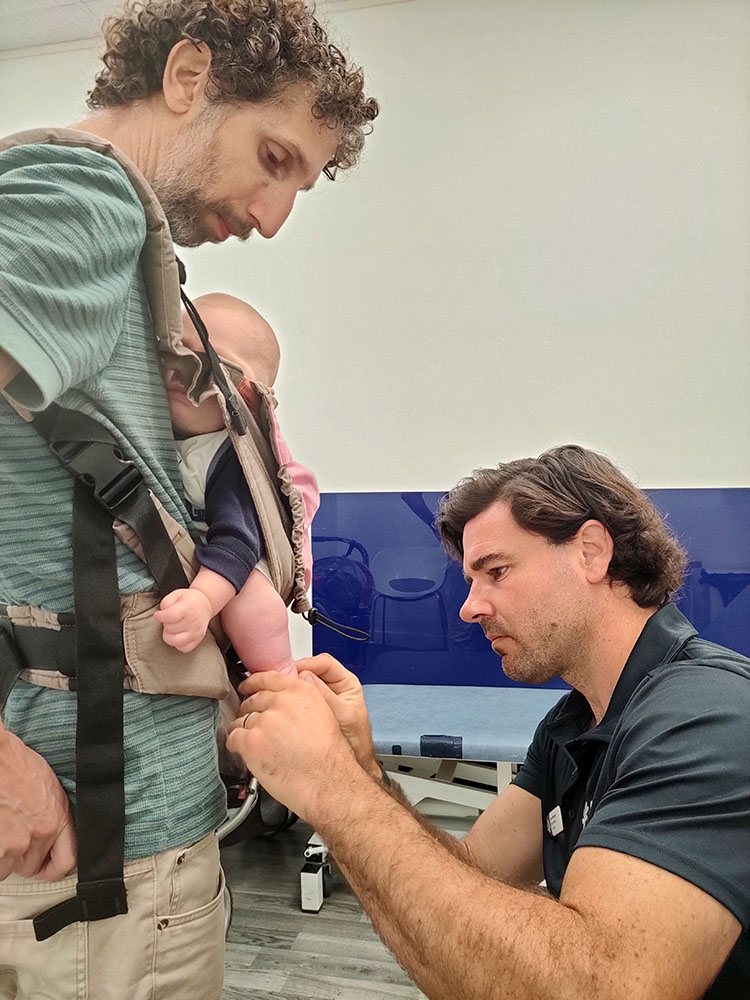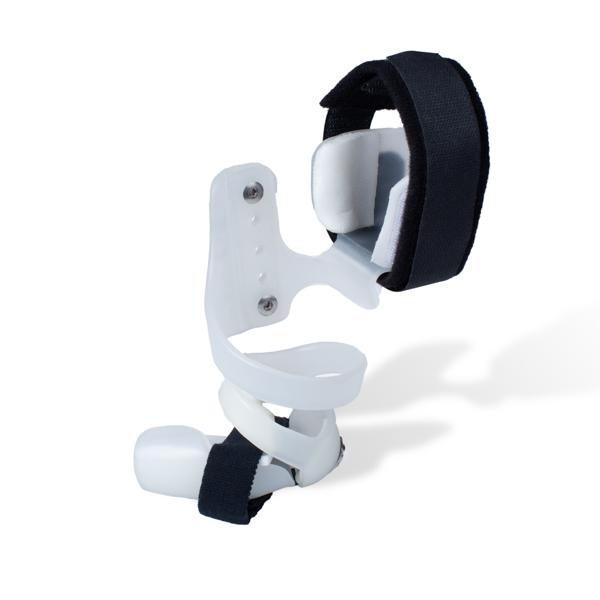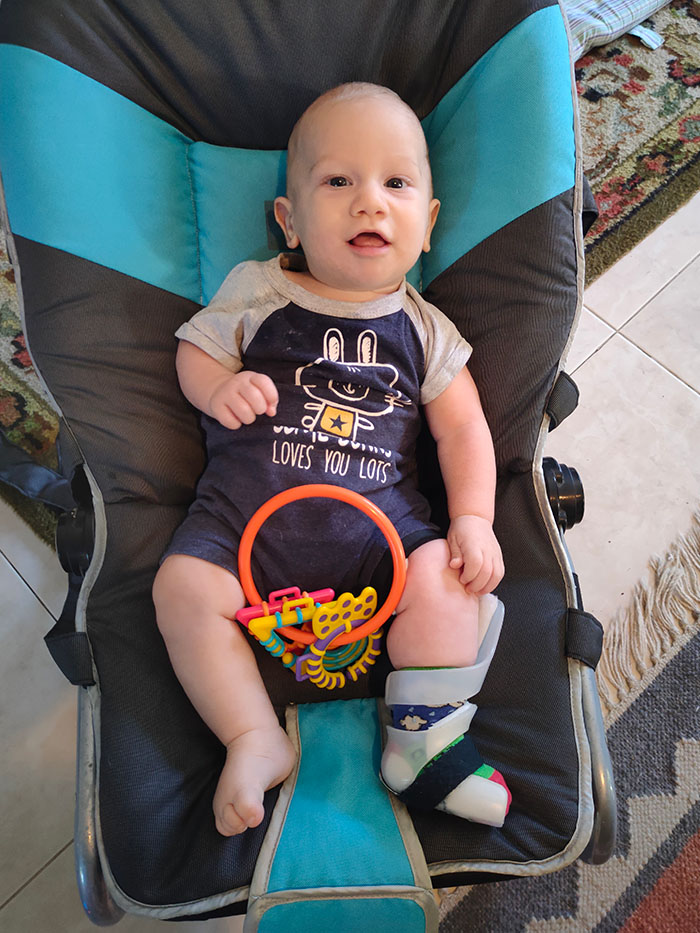
Orthotist and LOC Director Sam Walmsley with Tal during a club foot assessment
03 November 2023
At her 16-week scan, Shira discovered that one of the twins she was expecting had club foot in his left foot. At the time, the doctor said, ‘it’s nothing to worry about, it’s very treatable.’
Club foot, also known as congenital talipes equinovarus (CTEV), is a congenital condition in which a baby's foot is twisted out of shape or position. It's a fairly common birth defect, occurring in about 1 in every 1,000 births. Club foot can affect one or both feet and may vary in severity.
The characteristic features of a club foot include:
Not surprisingly, following the diagnosis, Shira hit the internet. What Shira discovered about treatment disturbed her. In Israel, where the family lived, the traditional treatment for club foot – the Ponseti Method – had only been introduced in 2000. Prior to that, foot surgery had been the only option available. What really upset Shira was what she read about the concluding part of the treatment, often referred to as the Boots and Bar approach. “This seemed to me to be an old-fashioned treatment, particularly as only one foot was affected. Fancy rendering a perfectly normal limb immobile for months if not years. This just did not make sense to me.”
Shira continued to research for a ‘single foot brace’ and found the Cunningham Brace, joined its Facebook group and was really encouraged by what she read. She also discovered that the London Orthotic Consultancy offered the treatment. She had found the solution but now she had to find a physician in Israel who would accept her son as a patient. This took some time, but she did eventually find Louis Schorr, who works at the Wolfson Medical Centre, and although he had never heard of the Cunningham Brace, he had an open mind to alternative treatments. The Wolfson were already treating club foot with an ADM (Abduction Dorsiflexion Mechanism), a single foot brace. In the meantime, Shira had contacted Sam Walmsley, director and lead orthotist at LOC, and they had a video call.
“Sam answered all my questions. We decided that Tal would come out of the cast first into the ADM brace so as not to be under time pressure.”

The Cunningham club foot brace
Club foot, or clubfoot, is the general name given for a medical condition called congenital talipes equinovarus (CTEV). Congenital means that you’re born with the condition, which can occur in one or both feet. It is quite common, occurring in around one in every 1,000 babies born in the UK.
The Ponseti method involves manipulation and repeated weekly casting for about five to eight weeks. After that, a small procedure called a tenotomy is carried out under local anaesthetic to lengthen the tight heel cord – known as the Achilles tendon – in the back of your ankle. The treatment follows very strict, well-understood protocols and is the gold standard in corrective treatment for club foot. Indeed, the procedure is used and endorsed by Great Ormond Street.
The Cunningham Brace was designed by Jerald Cunningham, who runs his own clinic in the US. It works using a firm strap around the thigh and a spring that holds the brace up against the bottom of the foot. This means that the brace is always gently stretching your baby’s foot into the correct position, in a similar way that a therapist applies manipulation.
Jerald developed the brace at the request of an orthopaedic surgeon and colleague who saw how distressing the boots and bar process was for many children and parents. Jerald has worked on the design for more than 10 years, tweaking as he goes, based on x-ray evidence after every patient fitting.
No problem. Often parents come to us after they’ve tried persevering with the boots and bar treatment for a few months. It may change our treatment plan a little and your child might need treatment for a bit longer, but the process will essentially be the same.
At the moment we can fit the brace at our clinics in Kingston-upon-Thames and Bristol; in addition, we can do follow up appointments at our Manchester clinic. There is a certain amount we can do virtually, but your first fitting would need to be done in person.
We have the following facilities and amenities at our Kingston Upon Thames location:
We also have the Gait Laboratory for orthotics patients and Onsite Manufacturing for speedy turnarounds and adjustments whilst you wait.
So, on the 12th September, Shira, her husband and the twins came to LOC in Kingston. “We were scheduled for 3 meetings day after day. The first morning we arrived at the clinic, Sam checked Tal’s foot and identified several problematic areas, which from the point of view of the medical staff at Wolfson were "yes, it's not great, but it should work itself out when he starts walking." The heel bone didn't come all the way down, the heel was actually quite empty. The base of the big toe was kind of pulled back, so it was tucked almost inside the foot, and shorter than the other toes (unlike the healthy foot). And there was also a bony protrusion under the hammer, where there really shouldn't have been one.
Other than that - things Sam didn't mention but mostly bothered me - there was a permanent wound at the buckle point of the ADM, constant swelling in the front of the foot from having to tighten the straps of the sandal so much, and the soft tissue in the calf also got some distortion from the pressure from the brace.
We were released for two hours to walk around Kingston, during which time Sam built on top of the basic Cunningham brace a variety of personal adjustments for Tal's foot, to address all the identified problems. Over the next two days, we showed up again every morning to check what worked, what didn't, where to fix, polish and make precise, add padding, remove padding... until everything sat perfectly without any discomfort.

Tal in his Cunningham Club Foot Brace
Tal has been wearing his Cunningham brace for almost a week. What have I noticed? All the signs of pressure have disappeared, the wound is fading, the foot is not crushed and not red/purple, the swelling in the front has come down and the deformity of the calf is less pronounced. After removal, slight red marks remain on the skin and that's it. The dorsiflexion is amazing. No comparison with the ADM. This brace is anchored above the knee (this is the only place where pressure is applied) and it mimics the effect of the cast in this respect.
The foot is always in the corrected position - but it has a full range of motion, the brace is soft and the leg can move freely. Unlike the ADM, this brace is not heavy, does not stick out, does not get caught in things, and best of all - the foot does not slide out of place, there is no need to take it off and put it on several times a day because the heel got away again. In fact, I forget he is wearing it and on busy days I have already forgotten to remove it for the one-hour break. You can put almost any pants over it, and underneath you don't need a special sock but a normal small sock (just without anti-slip). Because it is so minimalistic, he can wear it 23 hours a day until walking age.“
Tal’s progress will now be monitored remotely until he needs a new brace, and the family can once more visit LOC.
If your child has been diagnosed with club foot and you would like to know more about the Cunningham Brace, please contact us.